Fully Functional Miniature Weapon Models Crafted with Exceptional Quality and a Lifetime Service Guarantee
Weapons and Historical Figures of the 20th Century. Part II: The Good Guys
Зміст
Imagine the iconic figures of history—men who shaped the world with their courage and conviction—paired with the weapons that symbolized their fight for justice and freedom. In this article, we delve into the stories of these legendary individuals and the firearms that became extensions of their resolve. From Bat Masterson’s Colt Peacemaker to Winston Churchill’s Tommy Gun, each tale reveals how these tools of war, in the hands of the right people, served a higher purpose. Discover the fascinating interplay of character and armament that defined these “good guys” of the 20th century.
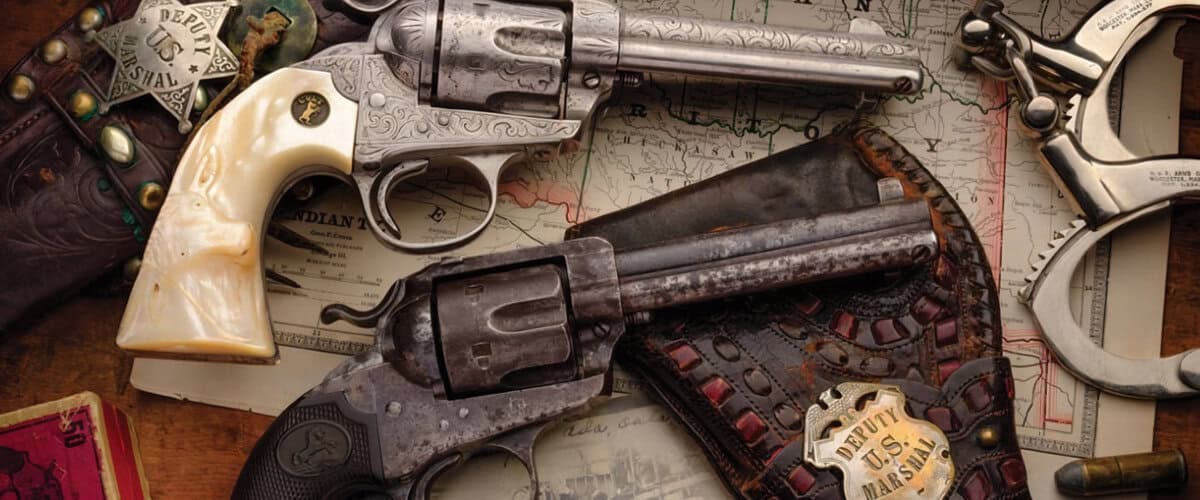
Bat Masterson & Colt Peacemaker
In the wild West, few figures stood as tall in both stature and legend as Bat Masterson. Known as a lawman, and sportsman, Masterson’s life was a tapestry woven from the threads of adventure, justice, and resilience. His name became synonymous with the Colt Peacemaker, a firearm that was as much a part of him as the code of ethics he lived by. Together, they carved out a legacy that embodied the complex narrative of the American frontier—where the lines between law and lawlessness were often blurred, but where good men made their mark with unshakeable resolve.
Born in 1853, William Barclay “Bat” Masterson was more than just another gunslinger of the Old West. He was a man driven by a deep sense of duty, whether it was as a sheriff, marshal, or as a voice of reason in the bustling, chaotic towns that dotted the frontier. Masterson’s reputation was not built on the number of men he killed, but on the lives he saved and the peace he enforced. He was known for his level-headedness and for bringing law to places where it was otherwise absent. Unlike many of his contemporaries, Masterson’s gun was a tool of last resort, used to protect rather than to provoke.
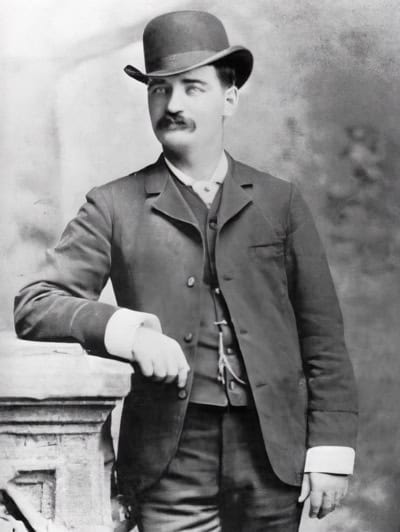
Masterson’s weapon of choice was the Colt Single Action Army revolver, more famously known as the Colt Peacemaker. This iconic firearm, with its six-shot capacity and reliable design, was the epitome of frontier justice. Introduced in 1873, the Peacemaker was designed to be as rugged and dependable as the men who carried it. For Masterson, the Colt was not just a sidearm; it was a symbol of the order he sought to maintain in a lawless land.
Though his Peacemaker was well-worn from years of service, it was not a weapon of reckless use. Masterson’s skill with the Colt was well-documented, but more importantly, he was known for his restraint. He believed in the power of the law and the importance of resolving conflicts without resorting to violence. However, when faced with no other choice, his aim was true and his resolve unflinching.
Bat Masterson’s life as a lawman was marked by moments of high drama, but also by quieter acts of courage and kindness. He was known to have helped the underdog, protected the innocent, and brought criminals to justice. His presence alone often defused volatile situations, as he commanded respect and exuded a sense of fairness that was rare in the rough-and-tumble towns of the West.
Bat Masterson and his Colt Peacemaker are reminders that the tools of violence can, in the hands of a just person, become instruments of peace. His story is one of a man who walked the line between chaos and order, always striving to tip the scales in favor of the latter. In a world that often celebrated the quick draw and the deadly shot, Masterson’s legacy is a testament to the fact that being a good man in the Wild West was about more than just wielding a gun—it was about knowing when not to.
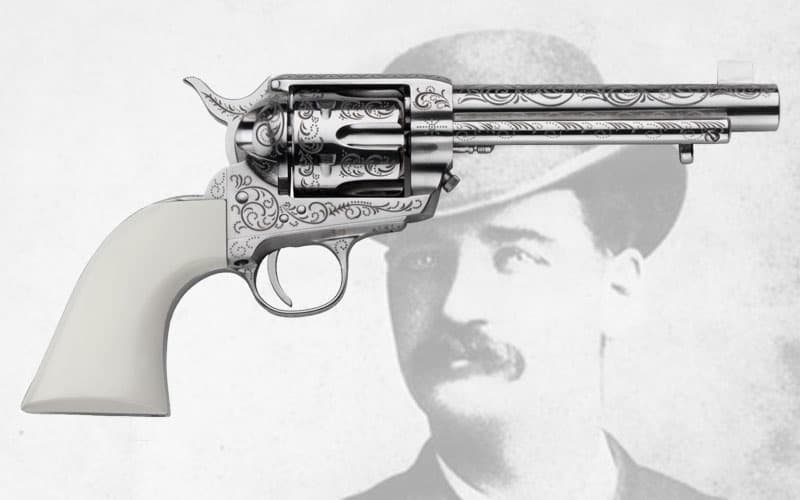
Theodore Roosevelt & Winchester
Theodore Roosevelt, the 26th President of the United States, was more than just a leader and statesman; he was a force of nature. Known for his larger-than-life personality, boundless energy, and unwavering sense of duty, Roosevelt embodied the spirit of the American frontier. A man of many pursuits—explorer, naturalist, and warrior—he was also an advocate for conservation and a champion of the common good. Central to his life in the wilderness was his trusty Winchester rifle, a firearm that played a significant role in shaping both his character and his legacy.
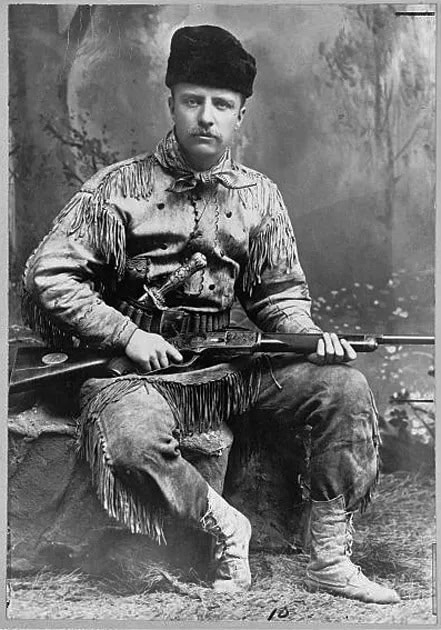
Born in 1858, Theodore Roosevelt was a sickly child who transformed himself through sheer willpower into a robust and vigorous man. His love for the outdoors and his passion for adventure were nurtured during his time in the Badlands of North Dakota, where he sought solace and renewal after the tragic loss of his wife and mother on the same day. It was in these rugged landscapes that Roosevelt honed his skills as a hunter and outdoorsman, often accompanied by his Winchester rifle.
The Winchester, particularly the Model 1895 lever-action rifle, was Roosevelt’s weapon of choice. This rifle, with its dependable mechanism and powerful caliber, was perfect for the big game hunts that Roosevelt cherished. But to Roosevelt, the Winchester was more than just a hunting tool; it was a symbol of the rugged individualism and self-reliance that he admired in the American character.
One of the most iconic moments in Roosevelt’s life was his role as a Rough Rider during the Spanish-American War. Leading the charge up San Juan Hill, Roosevelt’s bravery and leadership under fire became legendary. While his Colt revolver was often highlighted in accounts of the battle, the Winchester rifle was also a key part of his military arsenal. Roosevelt’s Winchester was not just a weapon of war, but a trusted companion that had seen him through both peaceful hunts and the heat of battle.
Theodore Roosevelt’s life was marked by a commitment to ideals that extended beyond the battlefield and the wilderness. He was a fierce advocate for justice, a proponent of the “Square Deal” for the American people, and a tireless reformer who fought against corruption and corporate greed. His Winchester rifle, with its association with the open frontier and the hunt, was a fitting symbol for a man who embodied the best of what America could be: strong, fair, and just.
Roosevelt’s legacy as a “good man” was not just in his use of the rifle, but in the principles he stood for. He understood that the true measure of a man was not in the power he wielded, but in how he used that power to protect the vulnerable, preserve the beauty of the natural world, and uphold the values of integrity and fairness.
Theodore Roosevelt and his Winchester rifle represent a unique chapter in American history, where the qualities of courage, conservation, and character were celebrated. Roosevelt’s life was a testament to the idea that a man could be both a warrior and a protector, a hunter and a conservationist. His Winchester rifle, always at his side, was a tool that helped him shape not only the landscape of America, but also its moral and ethical contours. In the hands of Roosevelt, the rifle became an instrument of a good man—a man whose legacy continues to inspire to this day.
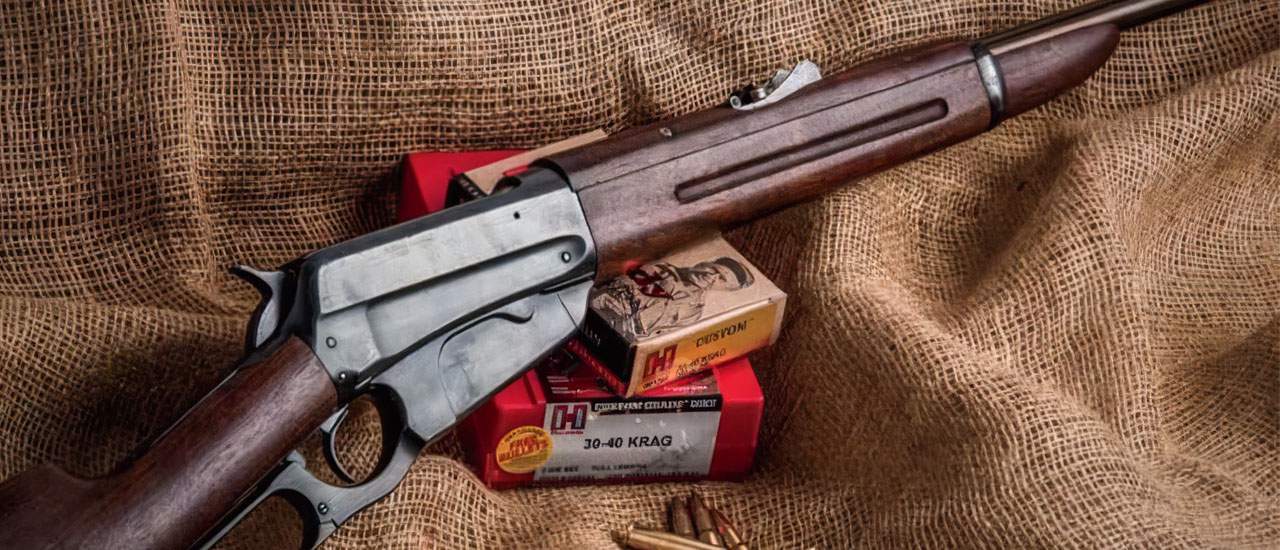
George S. Patton & Colt 1911
General George S. Patton, one of the most renowned and controversial military leaders of the 20th century, was a man of bold actions, fierce determination, and a deep-seated sense of duty. Known for his uncompromising leadership during World War II, Patton played a pivotal role in the defeat of Nazi Germany, a regime that epitomized the forces of evil. Throughout his military career, Patton was rarely seen without his signature sidearms, among which the Colt M1911 held a special place.
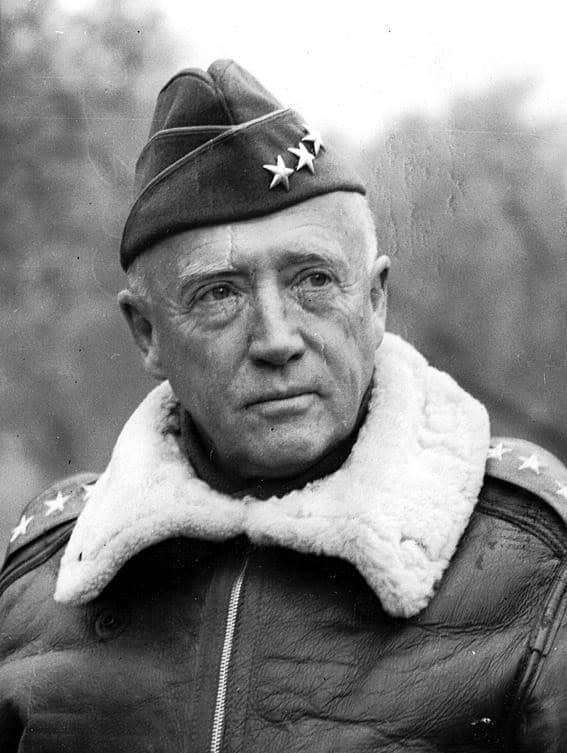
Born in 1885, George S. Patton grew up with a deep admiration for military tradition and the warrior ethos. By the time he entered World War II, he had already made a name for himself during World War I and the interwar period, establishing himself as a master of armored warfare and a leader who inspired fierce loyalty among his men.
Patton’s approach to warfare was direct and unrelenting. He believed in aggressive, fast-paced tactics, which he famously employed during the North African and European campaigns of World War II. His ability to outmaneuver and outfight the enemy earned him the nickname “Old Blood and Guts,” a moniker that reflected both his personal toughness and his relentless drive to achieve victory.
Among the many firearms Patton carried, the Colt M1911 was a constant companion. This semi-automatic pistol, designed by John Browning and adopted by the U.S. military in 1911, was known for its stopping power and reliability. For Patton, the M1911 was not just a weapon but a symbol of his personal and professional identity.
The Colt M1911 was Patton’s preferred sidearm during much of his service, and he was known to carry it alongside his other famous sidearm, the ivory-handled Colt Single Action Army revolver. Patton’s affinity for the M1911 was rooted in its practical effectiveness in combat. As a leader who often positioned himself near the front lines, Patton valued the dependability of the M1911, which he used not only as a weapon of last resort but also as a tool of personal protection.
Patton’s Colt 1911 was with him during some of the most critical moments of World War II. During the Sicily Campaign in 1943, Patton’s forces pushed the Axis powers off the island, paving the way for the Allied invasion of Italy. Patton was known to personally lead reconnaissance missions and often put himself in harm’s way. His M1911 was a constant companion during these perilous undertakings, symbolizing his readiness to defend himself and his men.
One particularly telling story from Patton’s career occurred during the Battle of the Bulge in December 1944. As the German forces launched a surprise offensive, Patton’s Third Army executed a rapid and daring counterattack that was crucial in turning the tide of the battle. Patton’s leadership was instrumental in the victory, and his personal courage under fire was exemplified by his willingness to face the enemy directly, with his M1911 at his side.
Patton’s role in the defeat of Nazi Germany was not just a military accomplishment; it was a moral crusade against an evil regime. Patton saw the war as a battle between good and evil, where the stakes were nothing less than the future of civilization. His personal bravery, underscored by his close relationship with his sidearms, made him a symbol of the Allied resolve to overcome tyranny.
The Colt 1911, in this context, became more than just a weapon—it was an emblem of the fight for freedom and justice. Patton’s use of the M1911 was always in service of a larger cause, and his determination to eradicate the Nazi threat was unyielding. He believed that his actions were part of a righteous campaign to liberate Europe from the clutches of totalitarianism.
George S. Patton’s legacy is one of fierce patriotism and unwavering commitment to the cause of freedom. His Colt 1911, alongside his other sidearms, was a tool that he wielded with both skill and responsibility. Patton’s life and career were defined by his belief in the power of decisive action and his dedication to the principles of courage, honor, and duty.
In the annals of military history, Patton is remembered not just for his victories on the battlefield, but for his embodiment of the warrior spirit. His Colt 1911 remains a symbol of his readiness to confront evil and defend the values he held dear. Through his actions and his leadership, Patton left an indelible mark on history, proving that in the face of great evil, a good man with a just cause and a trusty weapon can make all the difference.
General George S. Patton and his Кольт 1911 are inseparable elements of the story of World War II. Together, they represent the courage and determination of a leader who stood against one of the greatest evils of the 20th century. Patton’s use of the M1911 was emblematic of his readiness to fight for what was right, and his legacy continues to inspire those who value bravery, integrity, and the enduring fight for justice.
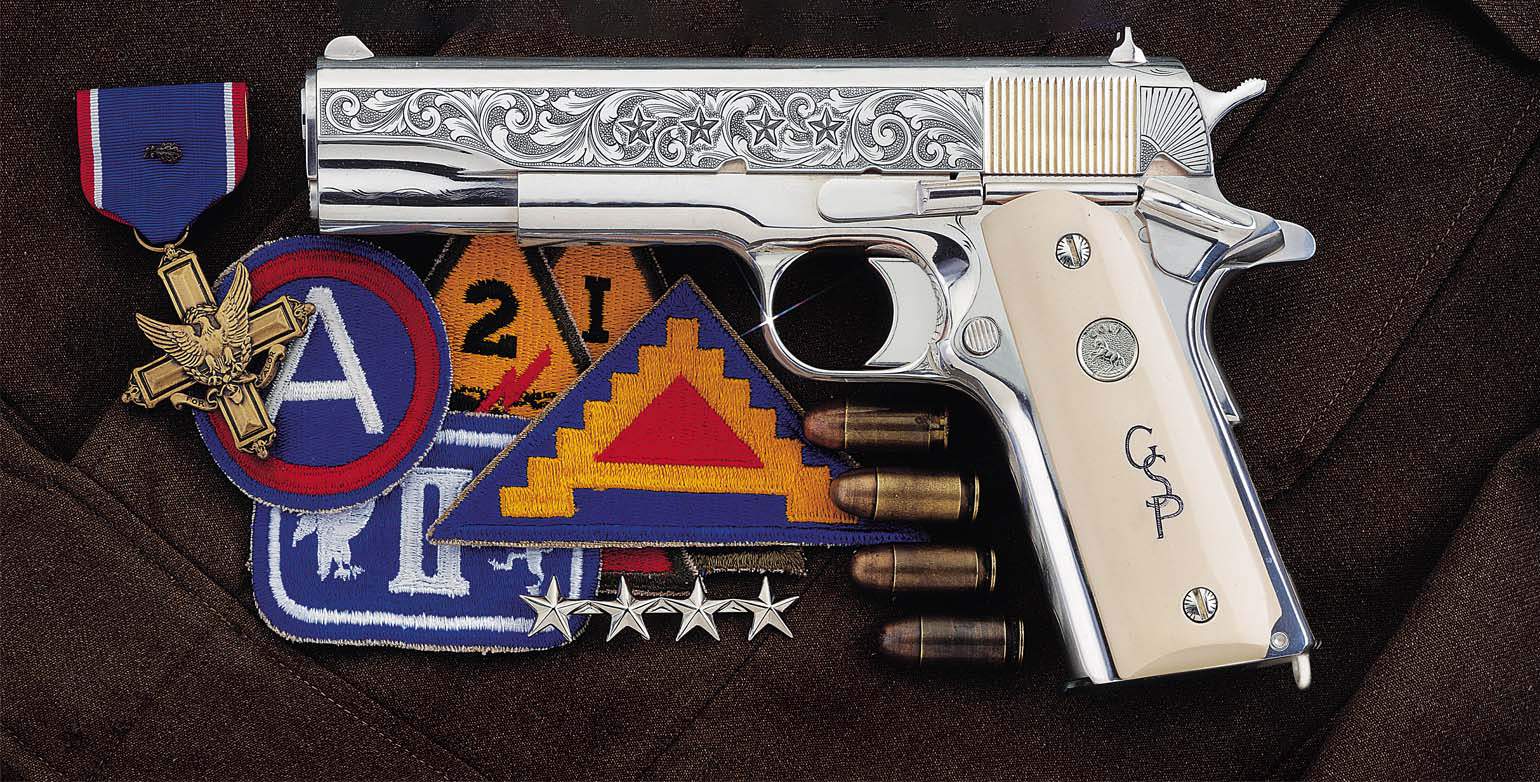
Winston Churchill & Tommy Gun
The image of Winston Churchill holding a Thompson Submachine Gun, commonly known as the Tommy Gun, is one of the most iconic photographs from World War II. Taken in 1940, during a visit to the coastal defenses in Hartlepool, England, the photograph captures Churchill in his trademark bowler hat and cigar, gripping the Tommy Gun with a resolute expression. This image, at first glance, is striking for its juxtaposition of a civilian leader with a weapon of war, but its deeper significance lies in what it came to symbolize during one of history’s most challenging times.
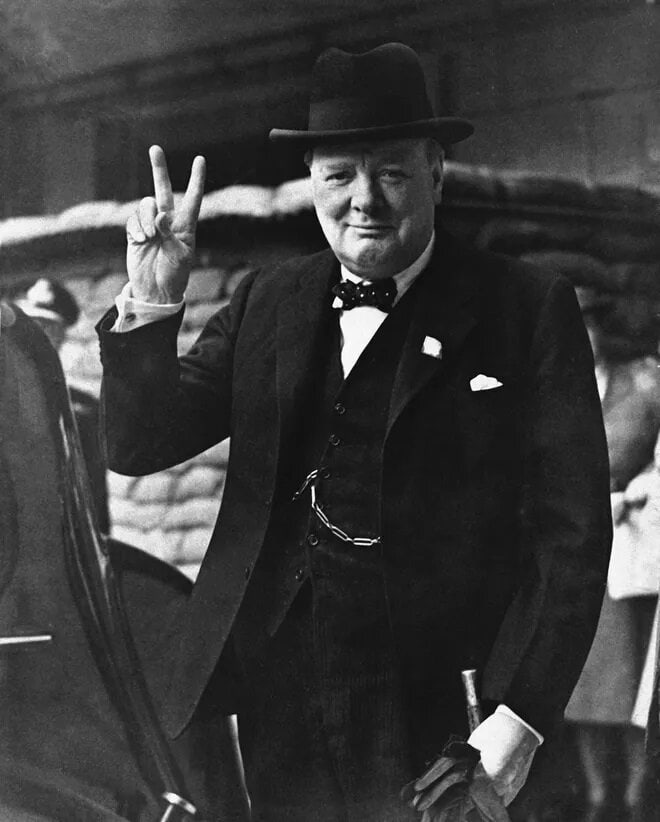
The photograph was taken during a crucial period of World War II when Britain was standing alone against the seemingly unstoppable might of Nazi Germany. After the fall of France, the threat of invasion loomed large over Britain, and the country was preparing for the possibility of having to defend its shores from the Nazis. Churchill, who had become Prime Minister in May 1940, was determined to rally the British people and demonstrate that they would fight with every resource available, including their resolve and their weapons.
The Thompson Submachine Gun Churchill holds in the photograph was not just any weapon; it was a symbol of both the modern technology of war and the determination of the British people to defend their freedom. The Tommy Gun, favored by gangsters during the Prohibition era in the United States, was now being repurposed as a tool of defense against tyranny.
This photograph of Churchill with the Tommy Gun resonated deeply with both the British public and the world at large. It became a powerful piece of propaganda, embodying Churchill’s defiance and unyielding spirit. The image sent a clear message: Britain was not just a passive victim awaiting its fate, but an active combatant ready to fight back against oppression.
In the cultural imagination, the photograph helped to solidify Churchill’s image as a wartime leader who was as comfortable at the frontlines as he was in the halls of government. It portrayed him as a man of action, willing to take up arms if necessary to defend his country and its values. This blending of civilian leadership with the symbols of military power made the photograph iconic, encapsulating the resolve and courage that defined Britain’s resistance during the darkest days of the war.
Winston Churchill, throughout his career, was known for his staunch belief in the moral righteousness of his causes. Whether as a soldier, politician, or statesman, Churchill saw himself as a defender of civilization against barbarism. In the context of World War II, his leadership was not just about military strategy but about leading a moral crusade against the evils of Nazism.
The pistol’s historical significance was not just in its material form but also in the narrative it helped shape. It became a focal point of discussions and stories surrounding Castro’s persona and Cuba’s revolutionary struggle against U.S. influence in Latin America.
The Tommy Gun in Churchill’s hands, therefore, took on a symbolic weight. It was not merely a tool of violence but an instrument of justice in the hands of those who stood against tyranny. In this sense, Churchill’s association with the Tommy Gun can be seen as a metaphor for the broader role of weaponry in the hands of those fighting for a just cause. The image suggests that when weapons are wielded by those committed to principles of freedom and humanity, they can serve a higher purpose.
Winston Churchill’s legacy as a “good man with a gun” is complex but deeply significant. He was a leader who understood the necessity of armed resistance against those who sought to destroy freedom and impose totalitarian rule. His willingness to embrace the tools of war was always tempered by his commitment to peace and his vision of a post-war world founded on democratic values and human rights.
The photograph of Churchill with the Tommy Gun remains a potent reminder of the paradox of war: that sometimes, the fight for peace and justice requires the use of force. It also underscores the importance of the character and intentions of those who wield such power. In Churchill’s hands, the Tommy Gun was not a symbol of aggression but of defense—a reminder that in the face of evil, good men must sometimes take up arms to protect what is right.
The image of Winston Churchill with a Thompson Submachine Gun is more than just a historical curiosity; it is a powerful symbol of leadership, resolve, and the moral complexities of war. It captures a moment when the free world was on the brink, and when the actions of a few brave individuals made all the difference. In the hands of Churchill, the Tommy Gun became an emblem of the fight for freedom and the belief that, in the struggle against evil, the tools of war could indeed serve the cause of humanity.
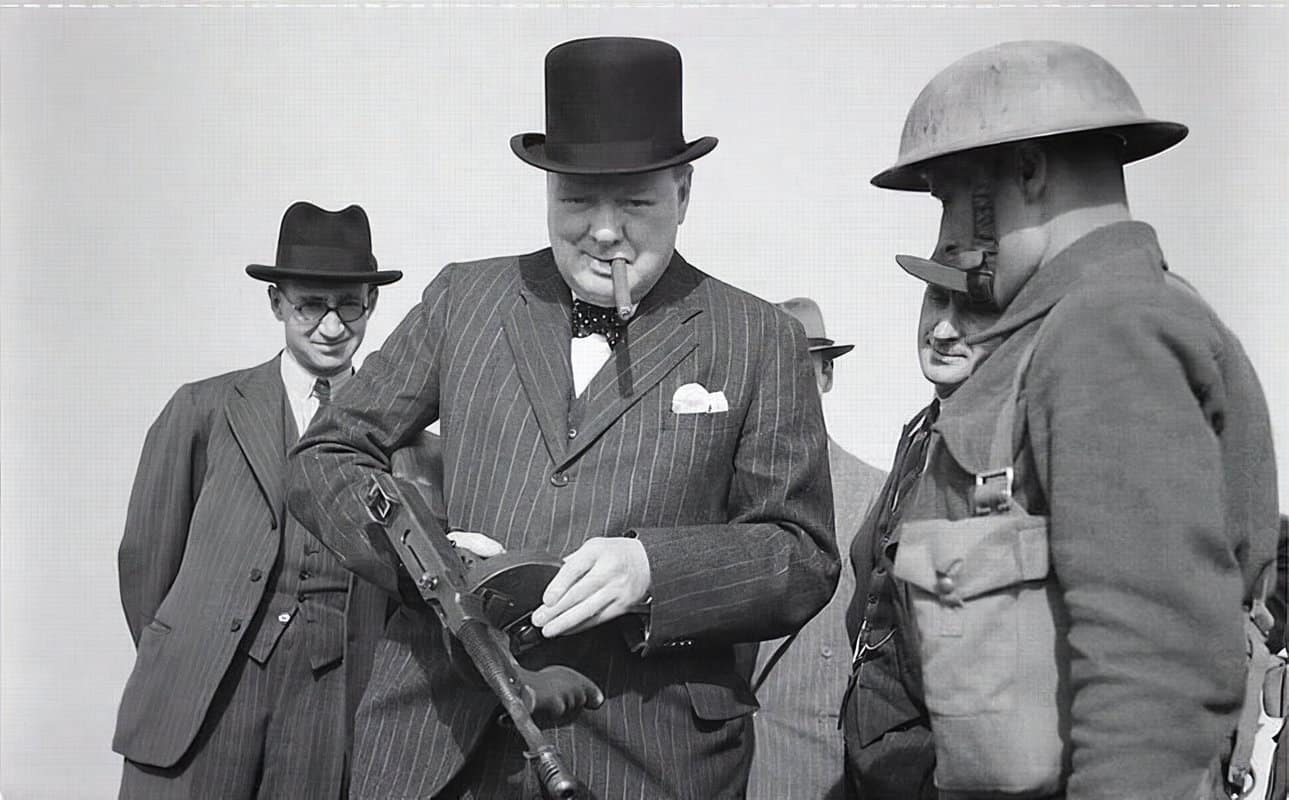
The stories of historical figures like Bat Masterson, Theodore Roosevelt, and Winston Churchill, and their iconic weapons, remind us that tools of war can transcend violence when wielded by those committed to justice. These “good guys” used their weapons not for power or dominance, but to uphold principles of freedom and righteousness. As we reflect on their legacies, we see that the true power of these weapons lies in the hands and hearts of those who use them to fight for what is right.
Про автора
Мене звати Ольга Полах, і я працюю у виробництві мініатюрної зброї з 2015 року. Я заснувала бренд мініатюрної вогнепальної зброї та з 2016 року веду Instagram-сторінку бренду. Мініатюри бренду користуються популярністю в усьому світі, маючи фанів у 25+ країнах. У 2018 році я стала єдиною власницею бренду та створила велику лінійку мініатюр. Більше 60 моделей мініатюрної зброї з різних історичних періодів було створено. У листопаді 2023 року я дала інтерв’ю Роберту Данну для журналу GunTech, де розповіла про труднощі, з якими я зіткнулася у своєму бізнесі. Також я веду інформаційний бюлетень для клієнтів бренду, який переріс у повноцінний журнал з глибокими статтями, що публікуються на wpolah.com.

Моя місія — зробити життя людей більш радісним, ділячись цікавими фактами про мініатюрну зброю та надихаючи кожного виражати себе.
